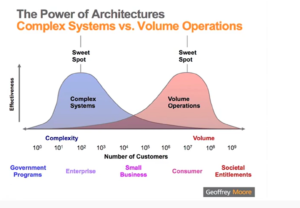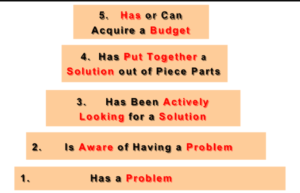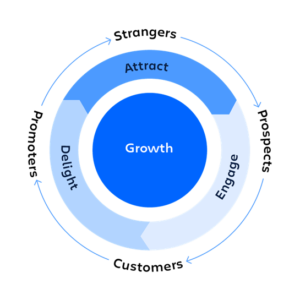Flywheels vs. relationships
Jul 25, 2022In developing an initial marketing plan, it is crucial not to be confused about what kind of business architecture you are building in order to establish your initial metrics for success. Geoffrey Moore has a great way of capturing this in the distinction between complex systems versus volume operations sales.

Which hand do you lead with?
Geoff likens the distinct business architectures to your organization’s “handedness.” In other words, we all have two hands, but for the most part use one more effectively than the other. In business, what that means is that there will be one taken-for-granted model for what we should align around. When you mix and match models, the inevitable result is a lack of alignment and confusion. Geoff explains in detail here. You can watch a recording of our Fireside Chat here.
The two models create value in entirely different ways. The complex systems model designs unique solutions for each customer situation, combining disparate elements that the provider differentially can access. Think IBM in systems integration or Goldman Sachs in complex financial instrument design. It’s a small-number-of-transactions model for a great big price. Customer frictions in this model are quite delightful, each representing an opportunity to sell a more advanced set of services.
The volume operations model serves many customers through frequent, (relatively) low-priced transactions that are absolutely standardized across its platform. The value created is to address repetitive customer jobs-to-be-done in as standardized and high-quality manner as possible. Think Amazon or Coca-Cola. Customer frictions in this model are a disaster – they interfere with the customers’ ability to complete a transaction and can disrupt your entire selling process.
Once you have figured out what your core architecture is, then the metrics you would want to establish for determining whether you are moving in the right direction flow naturally from that initial definition.
Metrics suitable for complex systems sales
A complex systems sale begins with the establishment of a high-quality relationship with a customer. Understanding customer issues and building trust are paramount. You would want to know the number and quality of the potential client network members, the nature of the conversations you are having with them and of course whether they have an ability to pay for the kind of high-touch, customizable services you might offer. Customer research is expressed in stories and anecdotes. The sales cycle can be very long – years, in some cases. That doesn’t mean you shouldn’t stay on top of keeping in touch and communicating. With these kinds of sales, you never know when the right intersection of problem / budget / decision will occur.
As Steve Blank lays out in his great book “4 Steps to the Epiphany,” and in this blog, the ideal complex systems customer has a problem, is aware that they have a problem, has been actively looking for a solution, has put together a not-so-great solution out of piece parts and has or can acquire a budget.

For their part, complex systems buyers want to know why they should trust you to solve their problems versus available alternatives. This means that to sell to them, you have to be credible. Signals of credibility include (though I hate the word) a position of “thought leadership,” publications in notable outlets, experience, association with prestigious institutions, degrees and other measures of authority and believability. The old line, “nobody ever got fired for hiring IBM” (or McKinsey, or BCG or insert other credible organization) exists for a reason.
Metrics suitable for volume operations sales
A volume operations business seeks to create a flywheel for sales. In these kinds of businesses, a zillion small actions eventually accumulate to create a large customer base that feeds an ongoing set of transactions. As Jim Collins, who features the model in his book “Good to Great” argues, the flywheel takes time to get going, but once it achieves momentum it is using its own force to keep turning.
Your goal in beginning to market such a business is to eliminate as many barriers to consumption by an end user as you possibly can, encouraging repeat purchasing and word-of-mouth referrals. This means you must be able to eliminate variation and anything customized. Anecdotes and war stories can be fatal here! Your market research needs to be as quantitatively oriented and experimental in-market tested as possible. Your designers and engineers are highly unlikely to share traits in common with the millions of customers your model will need.
Instead, you’ll want to think of how you can instrument your processes to create leading indicators of how well your flywheel is operating. Cameron Deatsch, the Chief Revenue Officer of software company Atlassian describes their flywheel as is illustrated below. The idea is to create a super-easy path for customers to go from being strangers to your brand to becoming fans and brand ambassadors.

As he points out, here you want to price for volume and consistency – everybody gets the same price, which should be standard and transparent so potential customers can know what it is without having to engage in a conversation. If you are offering a product that solves a real problem for customers, you shouldn’t need to “sell” it – let them buy it without human intervention. In the selling process for volume operations, as Deatsch says, “human interaction is a bug.” Ouch!
Implications for designing a marketing plan
The choice of business architecture is going to determine other key elements of your marketing plan. The design of your offers, how you talk about them and of course your unit of business will all be derived from that choice. It will also determine the kind of team you need to build, the digital presence you need to create and how much you’ll need to invest in what kind of brand-building. If you’re not clear on what your architecture is going to be, now would be a terrific time to get alignment around that with your team.
Meanwhile, over at Valize
We’re organizing a new cohort of learners for our six-module discovery driven and customer insight program. You’ll be joining with peers who will experience self-directed learning plus six hour-long live sessions with me, in two time zones so we accommodate most people. The price is meant to be very affordable at $695 (notice how I took my own advice, there?). You can test out whether you like the approach with our free demo course – opt in here. If you’d like to join the cohort, this is the place to sign up.
We’re also putting the final touches on a team effectiveness assessment that I’ll be talking about tomorrow at the World Agility Forum webinar – you can sign up for that for free.

